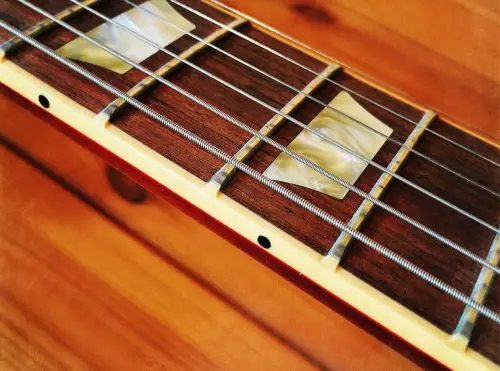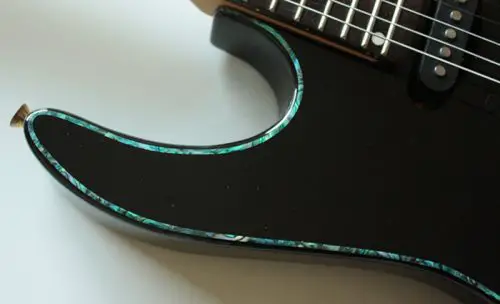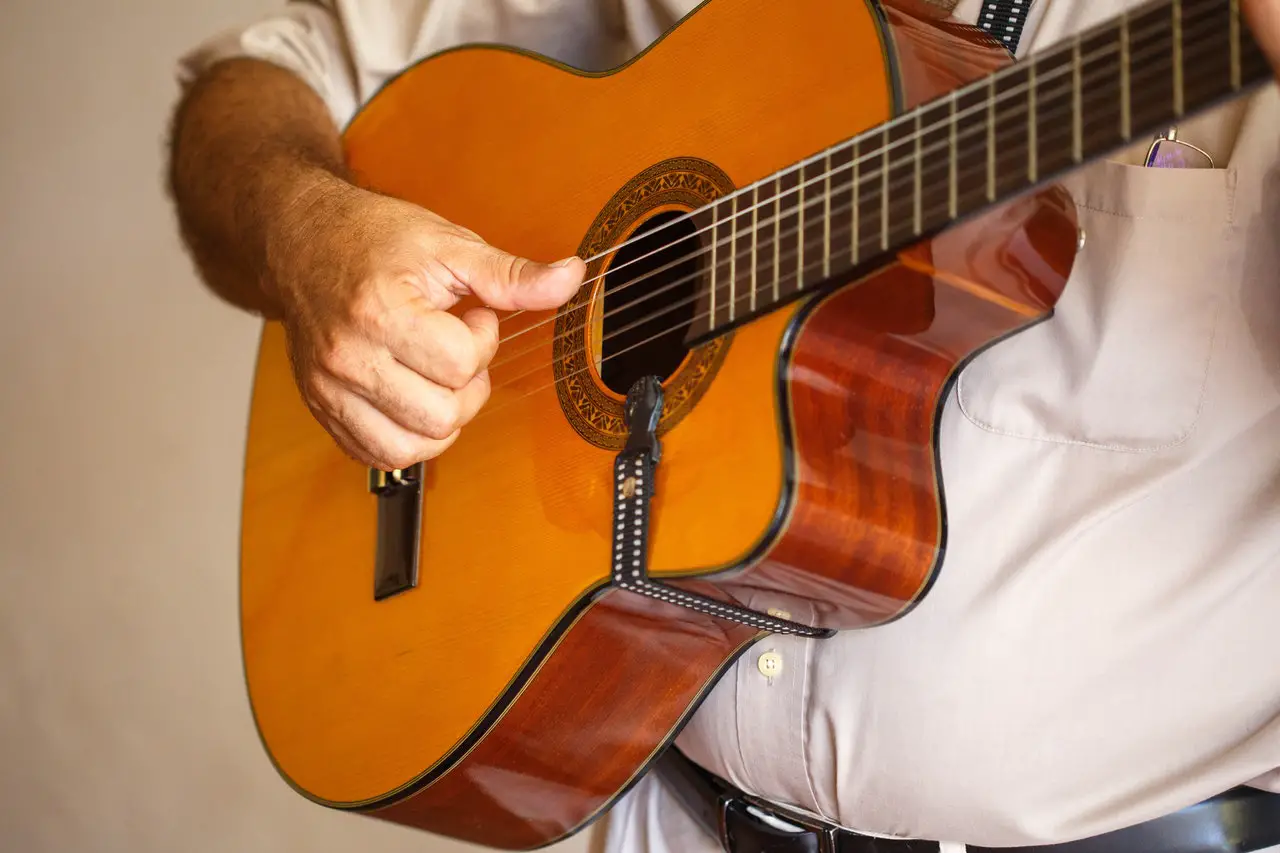The purpose of a binding is protection against minor dings and dents and this is why it is placed on the edges and occasionally on the side of fretboards/neck.
Neck binding can also be used to prevent or at least hide the frets that are sticking out, this happens when fretboard wood shrinks slightly and dries out, it could get really uncomfortable.
While neck binding protects your guitar in several ways it can be really expensive and make re-fretting your guitar much more difficult.
So, to understand what neck binding does to your guitar and whether you should go for it or not, keep reading as in this article I will be talking about:
1) What is neck binding?
2) What effect does it have on my guitar?
3) Advantages and disadvantages of neck binding
4) How to refret a guitar with neck binding?
5) Conclusion
What is neck binding?
Guitar neck binding is a technique that wraps the lining of a strip of material such as plastic, wood, or vinyl on the outside of the fretboard. The material not only gives protection but also gives the guitar a nice look.
The channel-bound necks have a compound-radius fingerboard that is inlaid directly into the neck. It eliminates the side seam between the neck and the fretboard.
Binding is a great option for those who do not like to feel the ends of frets sticking out while moving up and down the guitar neck. It gives a smoother ride to your fretting hand while you slide it. No matter how hard you polish the neck, an unbounded neck will never be as smooth as a bounded neck.
The bound neck also features abalone or purling inlays around the outside of the fretboard for decorative purposes. You can use different designs and shades if you want your guitar to look visually appealing.

Neck binding gives your guitar additional protection against scratches, dings and cracks.
How does neck binding affect my guitar?
Neck binding keeps your guitar safe from everyday mishaps such as minor dents or scratches along the edges while giving it a neat aesthetic look – it’s an extra layer of protection and cosmetic improvements.
Unbounded guitars may feel a little sharp around the edges, neck binding will give you a much smoother feel.
Other than the cosmetic purpose it also gives your guitar more durability by protecting the wood from getting gouged or chipped.
While all of this sounds great, binding can really empty your pockets. It can be quite expensive, especially for vintage guitars, and create problems during refretting.
Here are some of the advantages and disadvantages of neck binding that you need to know :
Advantages of guitar binding
1. Guitar binding doesn’t impact tone
Guitar binding will not cause a noticeable change to the tone of the guitar because it’s not structural and it only makes up a very small portion of the mass of any guitar that has it. I would be surprised if guitar binding had any noticeable effect on the sound.
You might come across people who can hear (or claim to hear) different battery voltages in their tube screamer pedals, they might have a sensitivity to a sound difference between bound and unbound.
They have this theory that the area around the binding will not vibrate as loud and the unbound neck because of all the glue and sealing, but in my whole experience with different guitars, I have never heard of such a distinction. The change in the vibration is way too small and insignificant.
2. Guitar binding protects the guitar
Neck binding is a great option to protect your guitar against bumps, scratches, nicks, or dents.
Instead of babying your guitar, you can actually have fun while playing it without having to worry about minor dings or scratches along the edges.
I used to baby my guitar a lot when I first got it – protecting it from any minor scratches. However, this didn’t last long. No matter how much I protected it, scratches and dings still come – which is why I am a fan of guitar binding.
It’s that extra peace of mind (and it looks pretty great too).
3. Guitar binding adds decorative feature
Neck binding frames your guitar and makes it look a bit more dressed up. It gives the guitar a neater look by smoothing out the frets that are sticking out which adds a visual element.
This decorative layer comes in different colors and materials and its main purpose is to give your guitar an additional accent for contrast.
Gives your guitar an aesthetic look and makes it stand out.
4. Guitar binding can be easily removed
Guitar binding, if damaged, can be easily removed and replaced then the wood it protects and this is exactly why it exists.
5. Consistent throughout temperature change
Neck binding with nibs will help the edge of the fretboard feel consistent through temperature changes.
The fretboard on an unbound neck tends to shrink due to lack of humidity which can make the fret edges sharp and it is no good as it gets difficult to play.
On the other hand, if you get the binding, the nibs replace that very last bit of fret that has been poking out, making it less of an issue
6. Higher resale value
Bounded guitar has a higher resale value because it’s expensive, keeps your guitar safe and makes it look premium.
It’s very common for a guitar to go higher in price just because it is bounded. But you have to be careful not to choose bindings that are too flashy. It may even lose value because no one likes the look of it!

Guitar binding with decals act as decoration
Disadvantages of guitar binding
1. Guitar binding is hard to refret
Guitar binding makes refretting slightly more expensive and difficult because the fret tang (the part that grips to the wood) needs to be cut back a bit to accommodate the binding.
It can cost you up to $100 more while refretting a bound guitar.
For refretting a guitar with neck binding you will have to be extra careful and patient. The process requires you to remove each fret, place a new one, and cut the extra part, all of this while making sure that each fret is placed perfectly and that there are no problems with the sound of the guitar.
2. Guitar binding is costly
Guitar binding is costly due to its labor cost – it takes a lot of work and a skilled luthier to do it right . It’s normal to get quoted starting from $300 excluding materials.
In the beginning, I was very surprised to find out about its cost. But after having gone through several bindings, I can tell you it’s worth it. Baby-ing a guitar is not fun and a good binding helps you protect your guitar for you.
This also depends on the guitar you have. Getting a binding on a cheap brandless guitar is definitely not worth it. You might as well get a new one and when your cheap guitar breaks.
Guitar binding is suitable for the guitar pieces that you love and want to keep as long as possible. Generally, I would recommend guitar binding if you have a guitar that costs around $1,000. Anything below needs to be reconsidered well.
How to refret a guitar with neck binding?
Refretting a guitar with a bound fretboard call for some additional time and care.
When it comes to a regular, unbound, neck, the wood of the fingerboard runs from edge to edge along the neck. This means that the fret slots also run from edge to edge.
So, if you look along the side of your guitar or bass neck, you will see about twenty tiny little slots that were cut into the fingerboard. And, if you look more closely, you will also see the ‘end’ of each fret. The tang will be visible in the slot.
However, when the neck is bound, there is a thin strip of binding (it can be either plastic, vinyl, or wood but other materials can also be used) that runs along either edge of the fingerboard. This hides the edges of the fingerboard wood and, therefore, the fret slots are not quite visible and this makes refretting a bit more difficult.
Obviously, you will have to know how to fit the frets. A standard-sized fret has a tang that runs its length. You can not just hammer this into a bound fingerboard as it will cause the tang to mar, mash, or generally ruin the binding. The frets have to be ‘undercut’.
Cutting the frets
Cut the frets to an appropriate size and remove a small section of tang from each side. The rest of the tang will fill the slot and the overhanging fret ends sit over the binding.
How to remove fret tangs?
The are two ways you can do it:
1. Remove fret tangs by hand
This is a cheap and most straightforward way to remove the tang. You just have to file it off with your hand.
It can be pretty time-consuming and you will have to be really careful as you can easily ruin the fret crown and will have to start all over again.
2. Snip the tang off
Another method is to just snip or nip the tang off. A sheet metal nibbler or a tool similar to that can do the job.
A good one of these tools that’ll do a productive job can be super hard to acquire. A search for ‘fret tang nipper’ will probably give you a lot of options. Some will be good but many will be awful.
A good nipper will give you a nice clean removal but still check for edges or burr that need to be cleaned up with a file.
So yes, refretting a bound neck can demand much of your time and attention but if you have the right tools and with the help of the guide above it can be quite easy and straightforward.
Conclusion
Neck binding enhances the visual appeal of the guitar and makes it stand out with its unique colors and patterns. It also gives you extra protection. It does not have any effect on the tone of the guitar and makes it look better so in my opinion there is no harm in getting your guitar bound.
Although the absence of neck binding is certainly not a deal-breaker. But your neck wood is important as it is the main wood your pickups sit in, so it is better not to risk it.
The only disadvantage is that you’ll have to spend some extra dollars but if you really care about your instrument you wouldn’t mind doing so, would you? Also, who does not like a dressed-up guitar!






